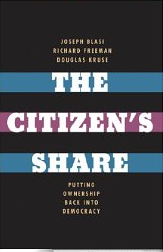
Main Idea:
The main idea of this book is simple: widely distributed property is necessary for existence of democratic state. The authors make case that moving from more or less equalized distribution of land as main productive asset at the time to highly unequal distribution of wealth and financial assets now jeopardizes continuing existence of democratic form of government and so the property should be democratized and redistributed much more equally then it is done now. The tool for such democratization of property is property sharing when employees own a significant share of company and get corresponding returns.
Details:
1. An American Vision
This chapter reviews founding father’s vision of America as land of property owning farmers self-sufficient in application of mainly their own labor to the land they own. In addition to founding father’s writing authors review Homestead Act as attempt to maintain this ideal of independent farmer. In the last part of this chapter they argue that substitution of land by corporation as main source of production make corporations a new land, subject to more equal distribution of property rights in this new land.
2. Examples
This is a set of examples of corporations that more or less widely distribute shares or profits to their employees. Examples include: Google, Procter & Gamble, Southwest Airlines and a bunch of smaller enterprises.
3. Citizen Shares in the United States
This is a review of current status of employees’ stock ownership with results of survey showing that 47% of American workers have some capital stake in their companies and/or profit sharing plan. The conclusion is that broad-based capitalism is pretty common in USA.
4. How it Evolved
This is a historical review of how such wide participation in corporate ownership developed. It starts with artisan small businesses as propertied class versus wage earners as propertyless class; goes through history of railroad ownership and than through the list of individual entrepreneurs and then corporate organizations that promoted broad-based capitalism as counter measure against class war between labor and capital.
5. Evidence
In this chapter authors report results of several studies of companies that use various forms of profit and property sharing. Overall results are positive in term of higher loyalty, higher level of involvement and effort, and better working conditions. Significant attention in studies was allocated to the problem of free riders – workers who, while receiving equal share, tend to minimize their input. As it could be expected, in such situations profit sharing increased social pressure on free riders making them to increase level of efforts.
6. The Road to Increasing Citizen’s Share
Authors see road to expansion of broad based capitalism in very typical for academician’s way – top down political pressure with National Goals and Objectives, government incentives and progressive taxation on capital gains. It also includes wide government supported program to educate population and businessmen in advantages of broad-based capitalism.
Epilogue
Here author restate their vision of Citizen’s Share and Broad-based capitalism as the way to assure political and economic success of United States.
My Take on It:
I agree with necessity of Broad-Based capitalism, as the only reliable way to achieve economic and political prosperity and even survival of American Society. However I have a problem with profit sharing and distributed ownership as main tools to achieve results. The problem of both these method is an absence of control over property for participating individuals except for top-level managers. These methods allow workers to get some share of return, but do not make them real owners of anything. By real owners I mean individuals who have both parts of ownership – title and control. Besides these methods leave outside everybody not employed in some business that would be more and more common even with advance of automated production of goods and services
My solution – to separate title (rights) to natural resources and actual control (decision-making) with rights being equal and marketable when users of more then average buying rights from users of less then average would make everybody equal owner of nature with owners of companies and capital being sole owners of their property. This way natural resources and related property rights are equally distributed, while human created resources belong to individuals who created them and / or to the most capable to combine human created and natural resources to produce goods and services in the most effective and efficient way as defined by market where such individual would be able pay more for use of natural resources then less efficient users.
